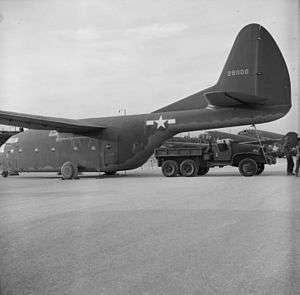Laister-Kauffman CG-10
The Laister-Kauffman CG-10 was an American military transport glider aircraft developed during World War II.
| CG-10 | |
|---|---|
 | |
| CG-10A | |
| Role | Transport Glider |
| Designer | Laister-Kauffman |
| First flight | 1943 |
| Primary user | USAAF |
| Number built | 5 |
Design and development
The development version was known as XCG-10. This version could carry 30 troops. It was accepted on October 4, 1943. The first test tow flight took place on November 6, 1943. The second version, XCG-10A, increased seating capacity to 42 and added a rear loading door.[1][2] Cargo capacity was up to 6 short tons (5.4 t).
The production version, CG-10A, had an initial order of 990 with the intention of being used for the planned invasion of Japan. 90 were on the production line when the program was cancelled. Laister-Kauffman considered fitting the planes with two Pratt & Whitney R-1830-92 engines but this plan never came to fruition.[2]
Specifications (XCG-10A)
Data from Fighting Gliders of World War II[3], United States Military Aircraft: CG = Transport Glider (1941-1955)[2], Popular Science February 1945 : What's New in Aviation[4]
General characteristics
- Crew: 2
- Capacity: 42 troops / 2½-ton truck / two 105mm M2 howitzers / one M1 155 mm Long Tom howitzer / one M2 howitzer with a 1-ton 4 x 4 truck / 10,850 lb (4,921 kg) payload
- Length: 67 ft (20 m)
- Wingspan: 105 ft (32 m)
- Height: 26 ft 3.6 in (8.016 m)
- Cargo compartment:
- Length: 30 ft (9 m)
- Width: 8 ft 6 in (3 m)
- Height: 6 ft 8.4 in (2 m)
- Wing area: 1,180 sq ft (110 m2)
- Aspect ratio: 8.15
- Airfoil: root: NACA 23018; tip: NACA 4412[5]
- Empty weight: 12,150 lb (5,511 kg)
- Gross weight: 23,000 lb (10,433 kg)
Performance
- Stall speed: 75 mph (121 km/h, 65 kn) flaps up
- 62–70 mph (54–61 kn; 100–113 km/h) flaps down
- Never exceed speed: 180 mph (290 km/h, 160 kn)
- 140 mph (122 kn; 225 km/h) flaps down
References
- Norton, Bill. American Military Gliders of World War II: Development, Training, Experimentation, and Tactics of All Aircraft Types. Atglen, PA: Shiffer Publishing, Ltd. p. 210.
- Heyman, Jos. "United States Military Aircraft: CG = Transport Glider (1941-1955)" (PDF). p. 12. Retrieved 3 September 2018.
- Mrazek, James E. (1 January 1977). Fighting Gliders of World War II (1st ed.). London: St. Martin's Press. pp. 121–123. ISBN 978-0-312-28927-0.
- "What's New in Aviation". Popular Science. February 1945. p. 85. Retrieved 3 September 2018.
- Lednicer, David. "The Incomplete Guide to Airfoil Usage". m-selig.ae.illinois.edu. Retrieved 16 April 2019.